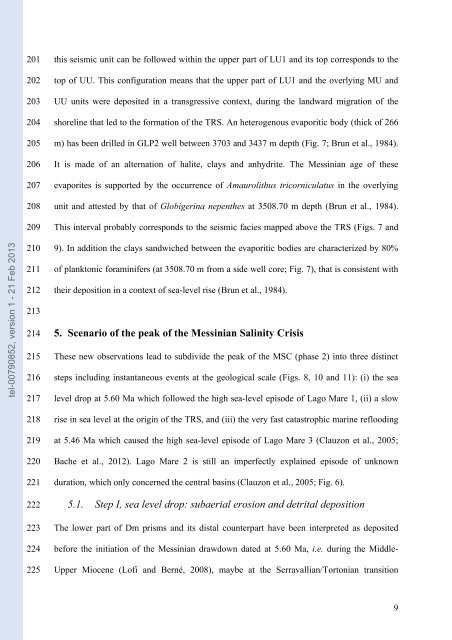Quantification des flux sédimentaires et de la subsidence du bassin ...
Quantification des flux sédimentaires et de la subsidence du bassin ...
Quantification des flux sédimentaires et de la subsidence du bassin ...
Create successful ePaper yourself
Turn your PDF publications into a flip-book with our unique Google optimized e-Paper software.
tel-00790852, version 1 - 21 Feb 2013<br />
201<br />
202<br />
203<br />
204<br />
205<br />
206<br />
207<br />
208<br />
209<br />
210<br />
211<br />
212<br />
213<br />
214<br />
215<br />
216<br />
217<br />
218<br />
219<br />
220<br />
221<br />
222<br />
223<br />
224<br />
225<br />
this seismic unit can be followed within the upper part of LU1 and its top corresponds to the<br />
top of UU. This configuration means that the upper part of LU1 and the overlying MU and<br />
UU units were <strong>de</strong>posited in a transgressive context, <strong>du</strong>ring the <strong>la</strong>ndward migration of the<br />
shoreline that led to the formation of the TRS. An h<strong>et</strong>erogenous evaporitic body (thick of 266<br />
m) has been drilled in GLP2 well b<strong>et</strong>ween 3703 and 3437 m <strong>de</strong>pth (Fig. 7; Brun <strong>et</strong> al., 1984).<br />
It is ma<strong>de</strong> of an alternation of halite, c<strong>la</strong>ys and anhydrite. The Messinian age of these<br />
evaporites is supported by the occurrence of Amaurolithus tricornicu<strong>la</strong>tus in the overlying<br />
unit and attested by that of Globigerina nepenthes at 3508.70 m <strong>de</strong>pth (Brun <strong>et</strong> al., 1984).<br />
This interval probably corresponds to the seismic facies mapped above the TRS (Figs. 7 and<br />
9). In addition the c<strong>la</strong>ys sandwiched b<strong>et</strong>ween the evaporitic bodies are characterized by 80%<br />
of p<strong>la</strong>nktonic foraminifers (at 3508.70 m from a si<strong>de</strong> well core; Fig. 7), that is consistent with<br />
their <strong>de</strong>position in a context of sea-level rise (Brun <strong>et</strong> al., 1984).<br />
5. Scenario of the peak of the Messinian Salinity Crisis<br />
These new observations lead to subdivi<strong>de</strong> the peak of the MSC (phase 2) into three distinct<br />
steps including instantaneous events at the geological scale (Figs. 8, 10 and 11): (i) the sea<br />
level drop at 5.60 Ma which followed the high sea-level episo<strong>de</strong> of Lago Mare 1, (ii) a slow<br />
rise in sea level at the origin of the TRS, and (iii) the very fast catastrophic marine reflooding<br />
at 5.46 Ma which caused the high sea-level episo<strong>de</strong> of Lago Mare 3 (C<strong>la</strong>uzon <strong>et</strong> al., 2005;<br />
Bache <strong>et</strong> al., 2012). Lago Mare 2 is still an imperfectly exp<strong>la</strong>ined episo<strong>de</strong> of unknown<br />
<strong>du</strong>ration, which only concerned the central basins (C<strong>la</strong>uzon <strong>et</strong> al., 2005; Fig. 6).<br />
5.1. Step I, sea level drop: subaerial erosion and d<strong>et</strong>rital <strong>de</strong>position<br />
The lower part of Dm prisms and its distal counterpart have been interpr<strong>et</strong>ed as <strong>de</strong>posited<br />
before the initiation of the Messinian drawdown dated at 5.60 Ma, i.e. <strong>du</strong>ring the Middle-<br />
Upper Miocene (Lofi and Berné, 2008), maybe at the Serravallian/Tortonian transition<br />
9

















